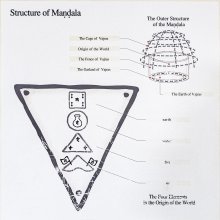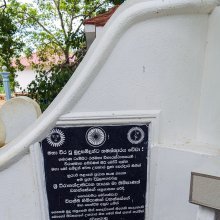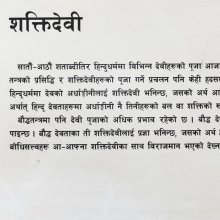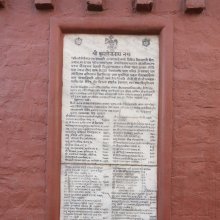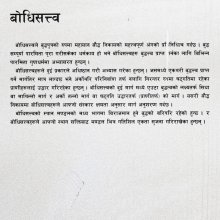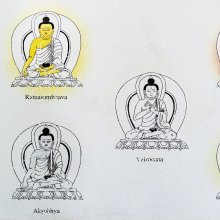Virajamana, Virājamāna: 6 definitions
Introduction:
Virajamana means something in Hinduism, Sanskrit, Buddhism, Pali, Marathi, Hindi. If you want to know the exact meaning, history, etymology or English translation of this term then check out the descriptions on this page. Add your comment or reference to a book if you want to contribute to this summary article.
Alternative spellings of this word include Virajman.
Images (photo gallery)
(+1 more images available)
Languages of India and abroad
Pali-English dictionary
Source: BuddhaSasana: Concise Pali-English Dictionaryvirājamāna : (pr.p. of virājati) shining.
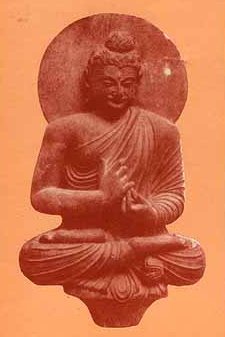
Pali is the language of the Tipiṭaka, which is the sacred canon of Theravāda Buddhism and contains much of the Buddha’s speech. Closeley related to Sanskrit, both languages are used interchangeably between religions.
Marathi-English dictionary
Source: DDSA: The Molesworth Marathi and English Dictionaryvirājamāna (विराजमान).—a virājita a (S Esp. in poetry and letters.) Glaring with splendor or beauty; gorgeous, lustrous, showy, fine. Ex. vi0 hōma karūna || baisati dhyāna dharōni ||.
Source: DDSA: The Aryabhusan school dictionary, Marathi-Englishvirājamāna (विराजमान).—a Glaring with splendour; fine.
Marathi is an Indo-European language having over 70 million native speakers people in (predominantly) Maharashtra India. Marathi, like many other Indo-Aryan languages, evolved from early forms of Prakrit, which itself is a subset of Sanskrit, one of the most ancient languages of the world.
Sanskrit dictionary
Source: Cologne Digital Sanskrit Dictionaries: Shabda-Sagara Sanskrit-English DictionaryVirājamāna (विराजमान).—mfn.
(-naḥ-nā-naṃ) Splendid, brilliant, handsome. E. vi before rāj to shine, śānac aff.
Source: Cologne Digital Sanskrit Dictionaries: Yates Sanskrit-English DictionaryVirājamāna (विराजमान):—[vi-rājamāna] (naḥ-nā-naṃ) p. Brilliant
Sanskrit, also spelled संस्कृतम् (saṃskṛtam), is an ancient language of India commonly seen as the grandmother of the Indo-European language family (even English!). Closely allied with Prakrit and Pali, Sanskrit is more exhaustive in both grammar and terms and has the most extensive collection of literature in the world, greatly surpassing its sister-languages Greek and Latin.
Hindi dictionary
Source: DDSA: A practical Hindi-English dictionaryVirājamāna (विराजमान) [Also spelled virajman]:—(a) (graciously) seated; sitting (used deferentially), gracing (an occasion;) by one’s presence; looking splendid/glorious.
...
See also (Relevant definitions)
Partial matches: Vi, Rajamana.
Full-text: Virajman, Akharva, Phadakanem.
Relevant text
Search found 5 books and stories containing Virajamana, Vi-rajamana, Vi-rājamāna, Virājamāna; (plurals include: Virajamanas, rajamanas, rājamānas, Virājamānas). You can also click to the full overview containing English textual excerpts. Below are direct links for the most relevant articles:
Garga Samhita (English) (by Danavir Goswami)
Verse 1.3.20 < [Chapter 3 - Description of the Lord’s Appearance]
Brihad Bhagavatamrita (commentary) (by Śrī Śrīmad Bhaktivedānta Nārāyana Gosvāmī Mahārāja)
Verse 2.2.133 < [Chapter 2 - Jñāna (knowledge)]
A History of Indian Philosophy Volume 4 (by Surendranath Dasgupta)
Part 3 - Brahman, Paramātman, Bhagavat and Parameśvara < [Chapter XXIV - The Bhāgavata-purāṇa]
Satapatha-brahmana (by Julius Eggeling)
Kāṇḍa VI, adhyāya 3, brāhmaṇa 1 < [Sixth Kāṇḍa]
The Great Chronicle of Buddhas (by Ven. Mingun Sayadaw)
Part 3 - King Suddhodāna’s invitation < [Chapter 16 - The arrival of Upatissa and Kolita]
